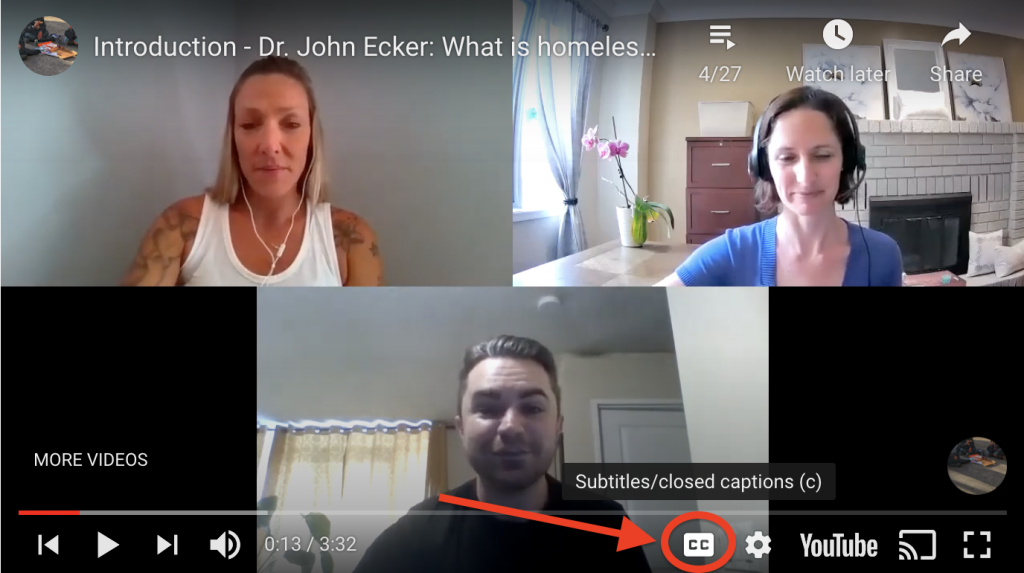Preface: About This Resource
Homelessness is an area of study that spans across academic disciplines. This was the premise with which we began this project. “Understanding Homelessness in Canada: From the Street to the Classroom” is a dynamic resource that can be used as a textbook, online course, and/or general interest book. Early in the design process, we had the idea to set up each chapter as a field of study, and we asked ourselves what three questions a student in that field might have about homelessness. We then reached out to many leading homelessness researchers across Canada and posed a sub-set of those questions to them. We recorded the conversations, created a series of videos from each, and imbedded them throughout this book alongside contemporary Canadian research with a focus on publications from 2018 and beyond.
We have included a range of academic disciplines in this book, divided into five parts consisting of Indigenous and Canadian Studies, Mental Health and Public Health Studies, Population Studies, Social Sciences, and Health Sciences. Our intention in doing so, was to provide instructors and students with a resource that contains information and opens a space for further exploration. We do not suggest that the chapters are a definitive resource for each academic discipline, but rather that they present information that students should know related to homelessness and their field. For instance, you will not learn how to be a Social Worker from the Social Work chapter, but you will learn key points Social Workers should know about homelessness. It is our intention that instructors and students will use this resource as a starting point and adapt it with their own theoretical and practical applications.
Each chapter begins with a real life scenario depicting one or more composite individuals. We have taken aspects of real people’s experiences and put them together in a way that highlights key social issues, without identifying any particular person. Throughout this book, you will also notice artwork created by people with lived experience of homelessness, additional information for students who want to learn more, and research ideas for students who wish to undertake an undergraduate or master’s thesis related to homelessness. Our team is very proud of this resource and hope that you will find it useful in your own journeys, learning and teaching about homelessness in Canada.
Direct Links
If you are an instructor who wishes to use the complete book, parts, or individual chapters you may wish to use the direct links below and imbed them directly into your learning management system (such as Blackboard, Moodle, or Canvas), so that students are able to easily locate the material.
A Note on Icons
Throughout this book, we consistently use a series of icons to identify key parts of each chapter. Below is an overview of what they mean and why you should be on the lookout for them.
 When the videos in this ebook are almost done playing, the message “Stop the video now” will appear in the top left corner. This is a reminder for those who have the Autoplay setting turned on to manually pause the video when the speakers are done to avoid having it autoplay through to the next video. This message will appear in all researcher videos throughout the ebook.
When the videos in this ebook are almost done playing, the message “Stop the video now” will appear in the top left corner. This is a reminder for those who have the Autoplay setting turned on to manually pause the video when the speakers are done to avoid having it autoplay through to the next video. This message will appear in all researcher videos throughout the ebook.
Each chapter is designed to answer three questions that students in the field of study might have about homelessness. This icon is used to indicate a “Featured Reading” related to each of the three questions. Each Featured Reading is Canadian, open-access, recently published, and accessible through a direct link next to the icon. For instructors using this ebook as an online course, we recommend assigning these Featured Readings as required reading.
about homelessness. This icon is used to indicate a “Featured Reading” related to each of the three questions. Each Featured Reading is Canadian, open-access, recently published, and accessible through a direct link next to the icon. For instructors using this ebook as an online course, we recommend assigning these Featured Readings as required reading.

At various points throughout the ebook we use this icon to draw your attention to online resources. These additional resources are points of interest, such as websites and blogs. These are designed to take you directly to the online resource by clicking the link. Please note, they will open in a separate window, so you do not lose your place in the ebook.
Throughout each chapter, we pose questions for students to stop and consider under the heading, “What do  you think?” This icon appears next to these questions to encourage students to temporarily pause and reflect upon the material they are reading and how they feel about it. Instructors may wish to use these as discussion questions, either in class or as part of an online discussion board.
you think?” This icon appears next to these questions to encourage students to temporarily pause and reflect upon the material they are reading and how they feel about it. Instructors may wish to use these as discussion questions, either in class or as part of an online discussion board.

At the end of each section, you will encounter this icon that provides a link to the “Understanding Homelessness in Canada” podcast. The researcher videos contained within the section have been compiled into a podcast episode, for readers who wish to download and listen to them again.
Navigating the Chapters
To navigate the chapters, you may use the “Contents” drop-down menu on the left-hand side by clicking on the “+” sign next to the main chapter title. Once you are in a chapter, you may also move through the sections by using the “Previous” and “Next” arrows at the bottom of the page (as shown in the image below). Each page will also have an up arrow at the bottom-middle to take you back to the top.

Closed Captioning
All of the videos in this ebook are fully captioned. However, depending on your own personal YouTube settings, you may need to turn them on if you want to view them. To turn on closed-captioning, click on the CC button at the bottom of the video player on the video you are watching.
We appreciate your interest in this resource, and hope that you will find it both engaging and informative. After you have read it, we hope that you will provide us with feedback: Share your thoughts with us
Happy Reading,
From the Understanding Homelessness in Canada Team

